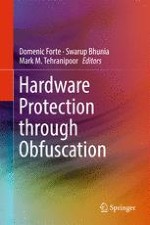
2017 | OriginalPaper | Buchkapitel
1. Introduction to Hardware Obfuscation: Motivation, Methods and Evaluation
verfasst von : Bicky Shakya, Mark M. Tehranipoor, Swarup Bhunia, Domenic Forte
Erschienen in: Hardware Protection through Obfuscation
Aktivieren Sie unsere intelligente Suche, um passende Fachinhalte oder Patente zu finden.
Wählen Sie Textabschnitte aus um mit Künstlicher Intelligenz passenden Patente zu finden. powered by
Markieren Sie Textabschnitte, um KI-gestützt weitere passende Inhalte zu finden. powered by